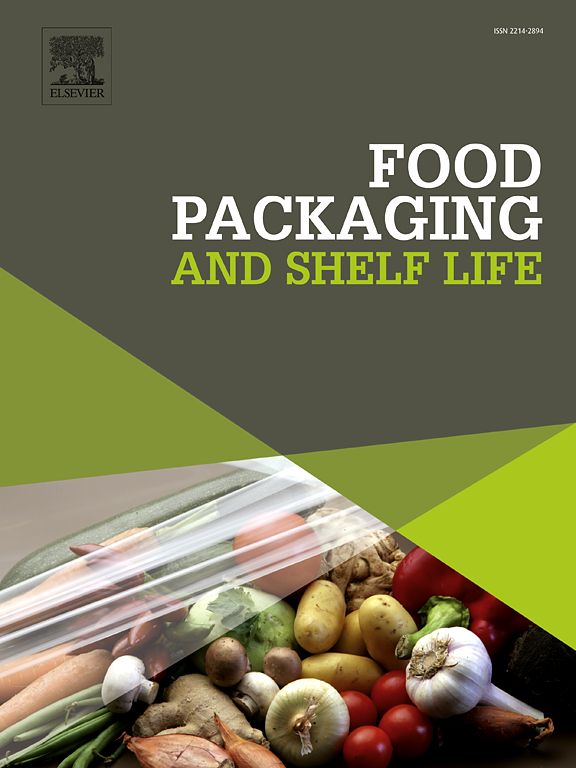当前纸板包装的使用:欧洲番茄包装景观的案例研究
IF 10.6
1区 农林科学
Q1 FOOD SCIENCE & TECHNOLOGY
引用次数: 0
摘要
目前减少食品塑料包装的压力导致对水果和蔬菜纸板包装的需求增加。此外,关于包装废物的新欧洲法规要求可回收和在包装中加入可回收纤维,这对安全性提出了挑战。潮湿条件下的耐腐蚀性对新鲜水果和蔬菜的纸质包装至关重要,而纤维素材料通常经过化学处理以改善这些参数。再生纤维中的含量也影响其抗湿性,因此影响施胶所需添加剂的组成。人们认识到,有几个因素影响纸板的性能,包括纤维来源,物理机械处理,散装成分和材料表面处理。这项工作旨在解决这些因素之间的关系,通过对在4个欧洲国家的高价和低价超市收集的圣女果包装进行深入的物理化学表征。样品在纤维来源、处理(漂白、印刷)、功能添加剂(表面或散装剂)方面各不相同。统计分析表明,可以根据相互关联的不同特性对样品进行分组,例如纤维类型和典型配方(即使用的增塑剂和功能添加剂)。材料在疏水性方面的性能差异很大。还测试了可重复性,作为可回收性的必要步骤。在样本中观察到许多与克莱默III类毒性有关的化学物质,如矿物油碳氢化合物、杀菌剂、双聚苯乙烯异构体和双酚A替代品。这项工作代表了更大规模的欧洲间研究的概念研究,并明确指出需要统一使用纸板作为食品接触材料的做法和法规。本文章由计算机程序翻译,如有差异,请以英文原文为准。
Current usage of paperboard packaging: A case study of the European landscape on tomato packaging
Current pressures to decrease plastic packaging for food have resulted in increased demand for paperboard packaging of fruits and vegetables. Additionally, the new European Regulation on packaging waste calls for recyclable and for incorporation of recycled fibre in packages which challenges safety. Resistance in humid conditions is critical for paper-based packaging for fresh fruits and vegetables and cellulosic materials are typically chemically treated for improving these parameters. The content in recycled fibre also affects the resistance to moisture and as consequence the composition in additives required for sizing. It is recognised that several factors contribute to the behaviour of the paperboard, including the fibre origin, physic-mechanical treatments, bulk composition and material surface treatments. This work aimed at addressing the relationship between these factors, by conducting a deep physic-chemical characterisation of packages of cherry tomato collected in 4 European countries, in both high and low-cost supermarkets. Samples varied in terms of fibre origin, treatments (bleaching, printing), functional additives (surface or bulk agents). Statistical analysis demonstrated that it is possible to group samples according to different properties that are inter-related, such as the type of fibre and typical formulations (i.e. plasticizers and functional additives used). Materials varied significantly in their performance regarding the hydrophobicity character. Repulpability was also tested as step needed for recyclability. A number of chemicals of concern with Cramer class III toxicity such as mineral oil hydrocarbon, biocide, DiPN isomers and BPA replacers were observed across the samples. This work represents a concept study for larger inter-European studies and clearly points to the need for harmonization of practices and regulations for the utilization of paperboard as food contact material.
求助全文
通过发布文献求助,成功后即可免费获取论文全文。
去求助
来源期刊

Food Packaging and Shelf Life
Agricultural and Biological Sciences-Food Science
CiteScore
14.00
自引率
8.80%
发文量
214
审稿时长
70 days
期刊介绍:
Food packaging is crucial for preserving food integrity throughout the distribution chain. It safeguards against contamination by physical, chemical, and biological agents, ensuring the safety and quality of processed foods. The evolution of novel food packaging, including modified atmosphere and active packaging, has extended shelf life, enhancing convenience for consumers. Shelf life, the duration a perishable item remains suitable for sale, use, or consumption, is intricately linked with food packaging, emphasizing its role in maintaining product quality and safety.
 求助内容:
求助内容: 应助结果提醒方式:
应助结果提醒方式:


